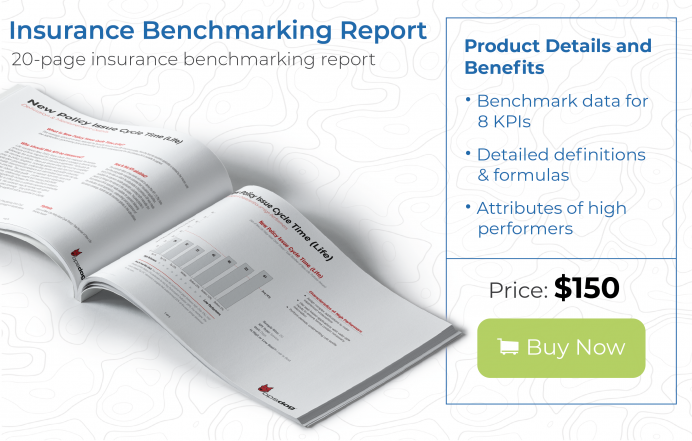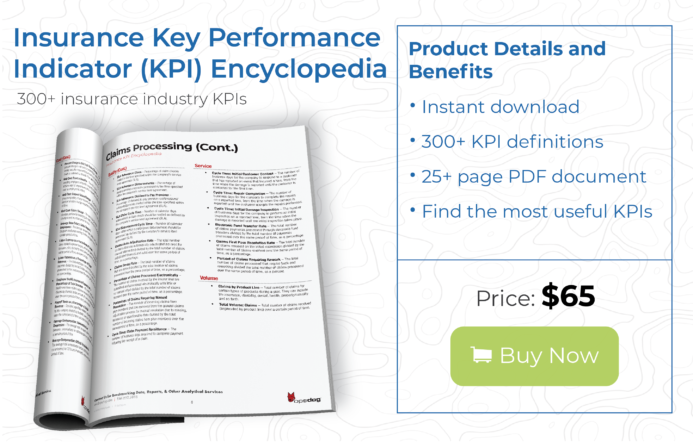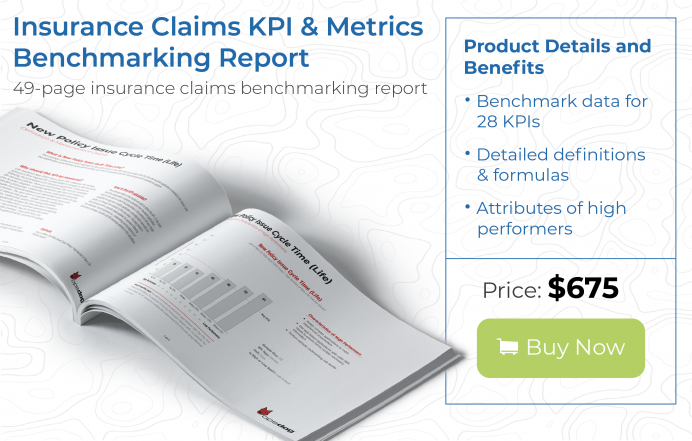It’s a simple equation: the higher the cost to manage claims, the lower an insurer’s profitability. Obviously insurers don’t want to rush the claims process and wind up mistakenly paying for fraudulent claims, but quickly–and accurately–processing legitimate claims has a direct, positive impact on the bottom line.
What are Insurance Claims Benchmarks?
An insurance claim is a formal request from a policyholder for compensation for a covered loss or policy event. Every type of insurer–whether property & casualty (P&C), life and annuities, automobile, medical, disability, or liability insurance—is required by law to make good on legitimate claims.
But it’s how insurers make good on claims that can make or break profits.
Insurance claims benchmarks measure the efficiency of the claims management process and analyze how much of a customer’s premium is spent paying for insurer’s administrative costs.
While there are many different types of claims, all insurers can benefit from using insurance claims benchmarks. A life insurer pays death benefits, a health insurer pays for medical exams, and a P&C insurer pays to repair a homeowner’s roof due to hurricane damage, but all three follow similar claims processes. All insurers intake claims information, validate the accuracy of the information, assess the correct claims amount based on policy guidelines, and make the payout to the policyholder or another designated party.
What does differ by type of insurer is what the actual benchmark number reveals. For example, the loss ratio for a health insurer tends to be higher than the loss ratio for a P&C insurer. It’s not helpful to compare ratios for insurers from differing lines of insurance.
How to Use Insurance Claims Benchmarks to Improve Processes
Insurance companies make money by collecting premiums and keeping operating costs low. Increased competition and empowered consumers who can price quotes from multiple carriers online makes it difficult for insurers to raise premiums too much, but insurers can use claims benchmarks to identity efficiency and leakage problems.
For example, if the cost to process claims is higher than the industry average, it could be that the claims department is overstaffed or that claims employees are undertrained. Or—it could mean that workflows are inefficient and claims are routed improperly. Or, perhaps claims forms are not fully completed, requiring too much back and forth between policyholders and the claims department to gather the information needed to process and settle the claim.
So, while a benchmark like cost per claim can indicate an issue, the insurer will need to investigate the root cause(s) to solve the problem.
Insurance Claims Benchmarks Examples
Here are six insurance claims benchmarks that insurance companies can use to improve their claims management processes:
Insurance Claims Benchmark #1: Combined Ratio
Combined ratio is a basic—but hugely telling—benchmark of an insurer’s overall profitability. Combined ratio compares the dollar amount of premiums an insurer earns minus the cost of claims paid and costs to run the company. There are a lot of factors that impact the combined ratio, and as an overall profitability metric, combined ratio doesn’t give enough detail to pinpoint problem areas. But, combined ratio is a common baseline metric to indicate the sustainability of the insurer.
To calculate combined ratio, divide the total loss ratio and underwriting expense ratio (see below) by premiums earned. The goal is to keep the combined ratio as low as possible.
Insurance Claims Benchmark #2: Underwriting Expense Ratio
Other than paying out claims, the biggest expense for insurers is simply running the business, including sales, underwriting, onboarding, customer service, and administrative functions such as HR, IT, and finance. Obviously, the goal is to keep these expenses as low as possible so insurers have more capital to cover claims losses and invest in sales, marketing, and distribution channels.
Underwriting expense ratio is the total dollar amount of operating expenses divided by premiums earned. Do not include claims paid and loss adjustment expense (LAE) in this calculation.
Insurance Claims Benchmark #3: Loss Ratio
Loss ratio is a widely used and oft-reported benchmark of how well an insurer performs and a measure of its financial health. The lower the loss ratio, the higher the insurer’s profitability. A high loss ratio can negatively impact the market value of a publically-traded insurer.
To calculate loss ratio, divide the total amount of paid insurance claims plus loss adjustment expenses (LAE) by the total premiums earned, as a percentage. Include both allocated and unallocated LAE. Do not include unearned premiums in the calculation.
Insurance Claims Benchmark #4: Cost Per Claim
Claims processing—including claims intake, adjustment, estimate, and settlement– is one of the most critical functions for an insurer and has a big impact on profitability and customer retention. Without a buttoned-up claims process, insurers may pay out more in losses than they need to. And lengthy claims processing not only costs the insurer more, but it frustrates customers. A high cost per claim could indicate poor adjuster productivity or inefficient manual processes.
To calculate cost per claim, divide the total cost of processing claims (labor, technology, and overhead) by the total number of claims processed.
Insurance Claims Benchmark #5: Claim Settlement Outbound Quality
The most efficient claims processing is both fast and accurate. Claim settlement outbound quality measures the accuracy piece of the claims processing puzzle: how many claims have a material defect, such as an incorrect payment amount or payment going to the wrong beneficiary. The higher the percentage of accurate claims settlements, the better.
To calculate, divide the number of clean claims by the total number of policies issued, as a percentage.
Insurance Claims Benchmark #6: Claims Closing Rate
Claims closing rate focuses on the speed part of the claims settlement equation by comparing the percentage of claims paid or denied payment to the number of claims opened. A higher percentage of claims closed means the insurer’s claims settlement process is efficient. A lower percentage could indicate that the claims process is hindered by manual steps or less productive claims employees.
To calculate claims closing rate, divide the number of claims settled by the number of claims opened, as a percentage.
Final Thoughts
Claims management is a complicated process with many moving parts—but it’s an area that can have a huge impact on insurer profitability. Although the actual ratios and percentages vary by type of insurer, all insurers can benefit from benchmarking their claims management process against their peers and competitors.
Are you tasked with reducing and minimizing insurance claims leakage? Find out how to accelerate those efforts here!
Choosing the right benchmarking metrics is crucial to claims process improvement, and that’s where we can help. For a complete list of insurance claims benchmarking metrics, download our comprehensive Insurance Benchmarking Report here.
If you need a deeper dive into benchmarking for your insurance claims operations, contact us for more information concerning our Benchmarking Research and Business Intelligence Implementation services for quick help with insurance benchmarking. We will provide you with affordable presentation-ready deliverables to help boost your productivity and operations.



